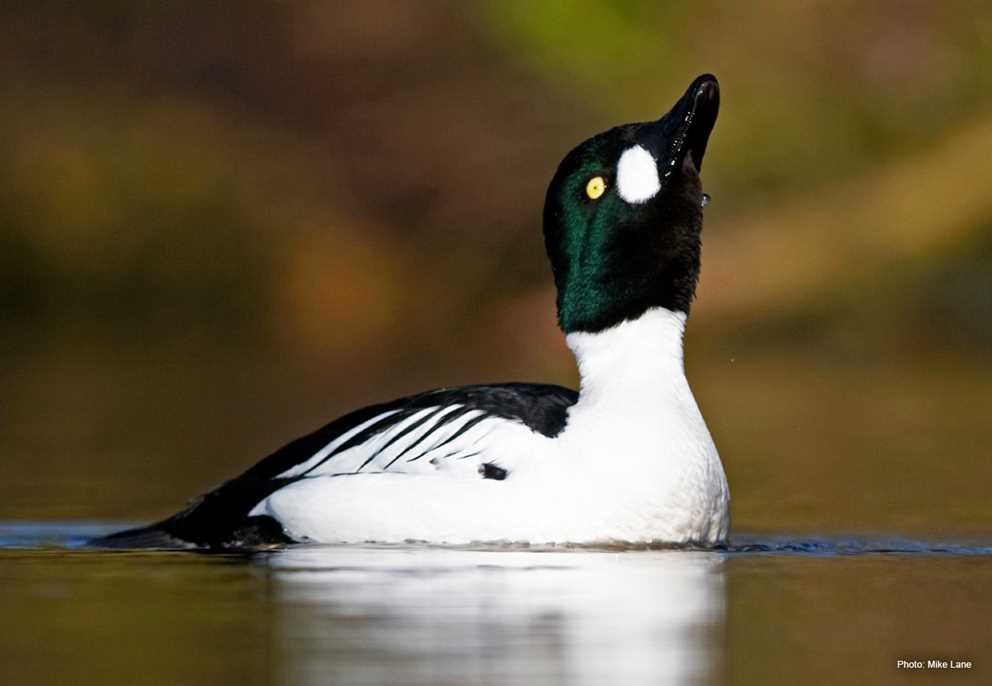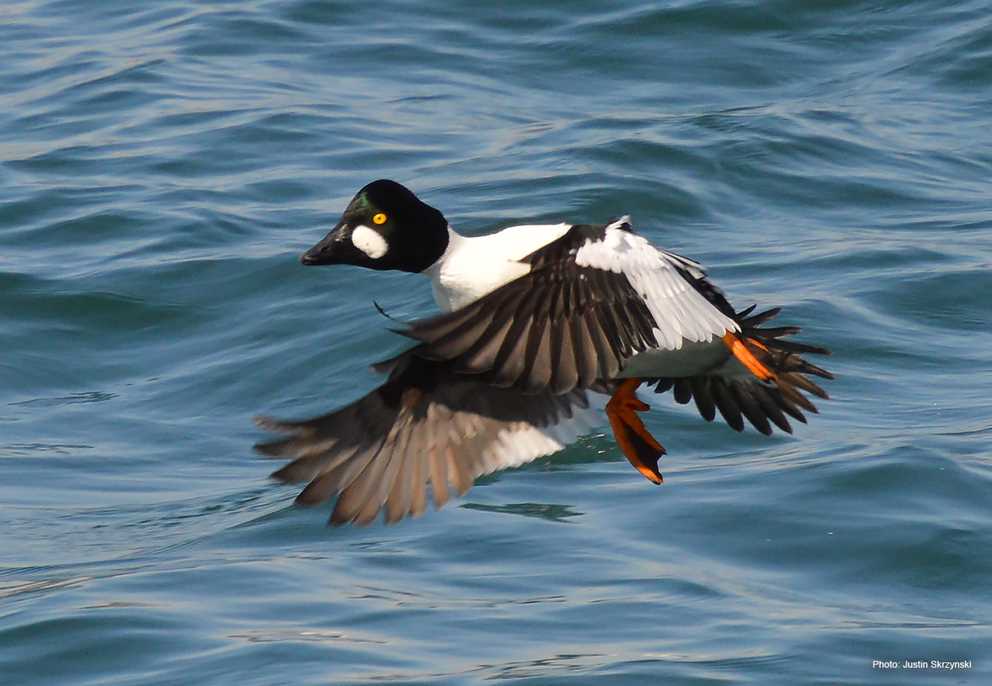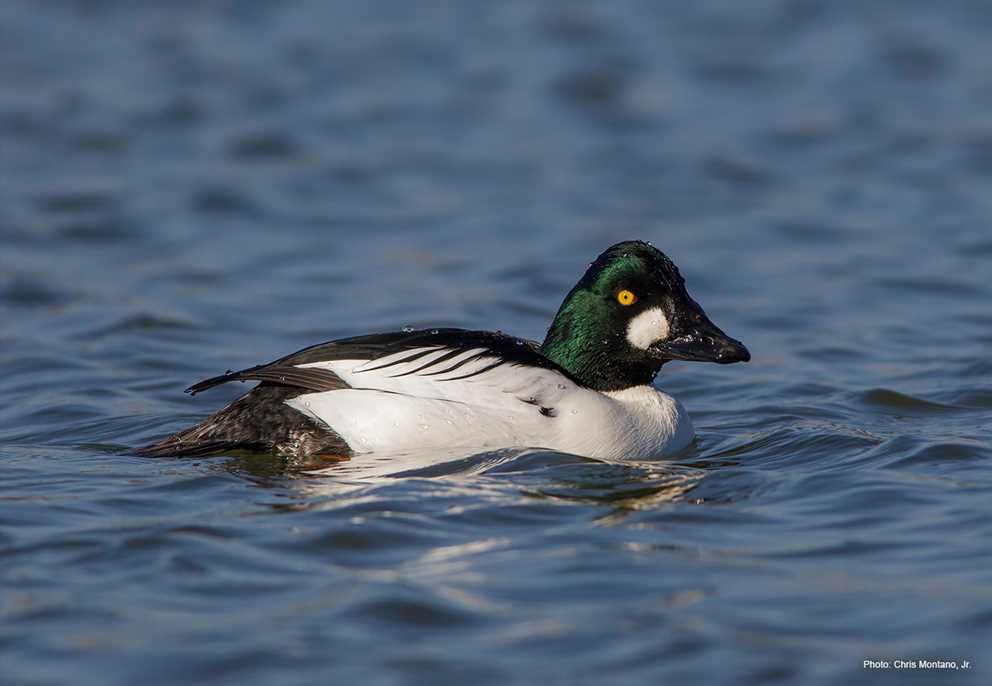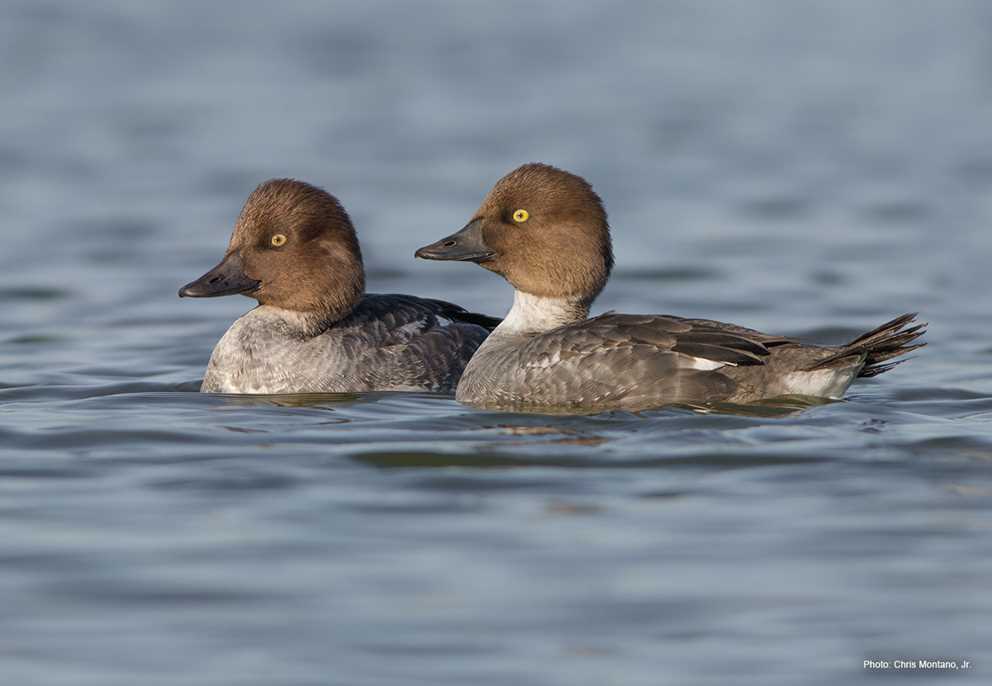Overview
The Common Goldeneye is a medium-sized diving duck with a circumpolar distribution. In North America, it breeds predominantly in boreal forest areas, with some breeding as far east as Newfoundland and Labrador. In winter, they occur the length of the Pacific Coast from the Aleutians to Baja, Mexico, and the Atlantic Coast from New Brunswick and Nova Scotia south to Florida and along the Gulf Coast, and they are also commonly seen on inland lakes and rivers throughout the United States, especially the Great Lakes. Common Goldeneyes are obligate cavity nesters using boreal lakes with an abundance of aquatic insects, with a preference for those that are free of fish to reduce competition for food with ducklings.
Description
Key Identification Features:
- Medium sized, black and white sea duck.
- In flight, wings of both sexes show significant white areas on the secondary coverts and feathers and the wing strokes cause a whistling sound.
- Males have a dark iridescent green head with a notable round white spot between the base of the black bill and gold eye.
- Females appear gray brown, with a brown head but lack the white spot between the bill and eye.
Male/Female Average Length and Weight
- Weight: Males 1.4–3.1 lbs.; Females 1.2–2.6 lbs.
- Wingspan: Males 8.5–9.7 in.; Females 7.4–9.0 in.
Male Identification:
- Alternate (Breeding) Plumage: Head black showing iridescent dark green in good light, with a round or oval white spot between the base of the bill and gold eye. Neck, breast, sides, and belly are white. The bill is black.
- Basic Plumage: Both sexes appear similar, with the head and upper neck brown, lower neck gray brown, back and sides brown. The head is dark brown, and in immature (first year) males, has a variable white spot at the base of the bill that increases as molt progresses through fall and winter. The bill is black.
Female Identification:
- Alternate and Basic Plumage: Head and neck are chestnut, lower neck white, chest and sides dark gray, belly white. Wings show white on secondary coverts divided with two black lines that separate into three white areas. The bill is black, except from about February to May females often show a yellow tip on the bill.
In-Flight Identification:
- Male: A whistling sound accompanies fast wingbeats, and a black iridescent head with a white patch and a black bill larger than that of a Barrow’s Goldeneye.
- Female: The gray body and brown head, as well as fast wingbeats and whistling sound may identify female Common Goldeneyes.
- The wings are black but show a large white patch on the secondary coverts and feathers in both sexes. In males the area is solid white, in females the white area is separated by two lines of black secondary coverts.
Vocalizations:
- Usually silent.
- Male Calls: Males make short, faint “peent” in courtship.
- Female Calls: Females give a harsh croak alarm call “gaak.”
Similar Species:
- Barrow’s Goldeneye: Adult males may be confused with male Barrow’s Goldeneye. Easily distinguished in alternate plumage by shape of the white facial marking, which is round or oval in Common Goldeneye, and crescent shaped in Barrow’s Goldeneye. Male Common Goldeneyes also have more white on the secondary feathers, and the head is more peaked, and forehead and bill more sloped than Barrow’s Goldeneye. Females of these two species are easily confused, but the Common Goldeneye has a longer, sloped forehead, and more white secondaries (total of 5–8 are pure white) versus Barrow’s Goldeneye (only 0–4 pure white secondaries).
Habitat Preferences
- Breeding: Breeding Common Goldeneyes are typically found on freshwater boreal wetlands, lakes, and rivers. Preference for wetlands with clear water, abundant aquatic insects and no fish that compete with ducklings for food.
- Migration and Wintering: In migration and winter, they occur the length of the Pacific Coast from the Aleutians to Baja, Mexico, and the Atlantic Coast from New Brunswick and Nova Scotia south to Florida and along the Gulf Coast. Wintering Common Goldeneyes are also commonly seen on inland lakes and rivers throughout the United States, especially the Great Lakes.
Foraging Habits and Diet
- Common Goldeneyes are diving ducks and forage extensively on invertebrates throughout the annual cycle.
- Breeding Season: During spring and summer, they primarily feed on aquatic insects, amphipods, and snails.
- Migration and Winter: In migration and winter, they consume a wide range of invertebrates, especially crustaceans, bivalves, and some fish and fish eggs.
Breeding Habits
- Monogamy: Common Goldeneyes are believed to be serially monogamous.
- Nest Locations: Common Goldeneyes are obligate cavity nesters but also readily use nest boxes.
- Clutch Size: Clutch size averages 8–10 eggs, but dump nests may have many more eggs. The eggs are elliptical to oval, greenish to olive green, and average 2.36 by 1.1.73 in. The incubation period is 28–32 days.
Migration and Distribution
- Fall Migration: Common Goldeneyes are among the latest fall migrants, departing breeding areas with onset of ice cover in mid- to late October. They arrive in migration and winter areas in November and December.
- Spring Migration: Relatively early spring migrant, starting in February or March, with an April or early May arrival on breeding areas often timed with thaw of wetlands.
Conservation Status
- IUCN Status: Least Concern
- Population Status: The North American population estimate is about 1.0 million birds, assumed to be stable, but estimates are poor because of difficulty surveying this species.
- Conservation Concerns: The primary threats include habitat loss, acid rain, sedimentation, forestry (removal of nesting trees), and river channelization.
- Conservation Focus: Nest boxes are sometimes used to aid populations in areas where suitable nesting trees have been removed.
Harvest Information
- Please note this combined for the two species An average of 83,577 Goldeneyes were harvested per season across the US during the 2019 through 2022 hunting seasons.
- Goldeneye harvest is highest in the Pacific Flyway, accounting for 30 to 40 percent of the total US harvest.
- The top three harvest states for Goldeneyes across the 2019 –2022 hunting seasons were Idaho (47,250), Kansas (45,030), and Montana (28,301).





